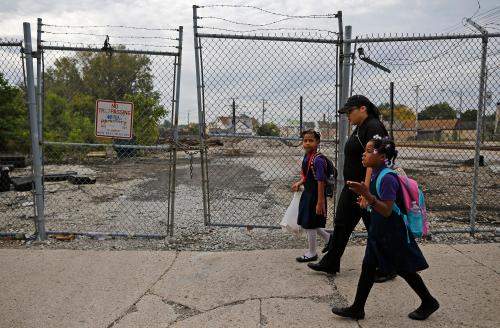Even as the U.S. economy hums along at a favorable pace, there is a vast segment of workers today earning wages low enough to leave their livelihood and families extremely vulnerable. That’s one of the main takeaways from our new analysis, in which we found that 53 million Americans between the ages of 18 to 64—accounting for 44% of all workers—qualify as “low-wage.” Their median hourly wages are $10.22, and median annual earnings are about $18,000. (See the methods section of our paper to learn about how we identify low-wage workers.)
The existence of low-wage work is hardly a surprise, but most people—except, perhaps, low-wage workers themselves—underestimate how prevalent it is. Many also misunderstand who these workers are. They are not only students, people at the beginning of their careers, or people who need extra spending money. A majority are adults in their prime working years, and low-wage work is the primary way they support themselves and their families.
Low-wage work is a source of economic vulnerability
There are two central questions when considering the prospects of low-wage workers:
- Is the job a springboard or a dead end?
- Does the job provide supplemental, “nice to have” income, or is it critical to covering basic living expenses?
We didn’t analyze the first question directly, but other research is not encouraging, finding that while some workers move on from low-wage work to higher-paying jobs, many do not. Women, people of color, and those with low levels of education are the most likely to stay in low-wage jobs. In our analysis, over half of low-wage workers have levels of education suggesting they will stay low-wage workers. This includes 20 million workers ages 25-64 with a high school diploma or less, and another seven million young adults 18-24 who are not in school and do not have a college degree.
As to the second question, a few data points show that for millions of workers, low-wage work is a primary source of financial support—which leaves these families economically vulnerable.
- Measured by poverty status: 30% of low-wage workers (16 million people) live in families earning below 150% of the poverty line. These workers get by on very low incomes: about $30,000 for a family of three and $36,000 for a family of four.
- Measured by the presence or absence of other earners: 26% of low-wage workers (14 million people) are the only earners in their families, getting by on median annual earnings of about $20,000. Another 25% (13 million people) live in families in which all workers earn low wages, with median family earnings of about $42,000. These 27 million low-wage workers rely on their earnings to provide for themselves and their families, as they are either the family’s primary earner or a substantial contributor to total earnings. Their earnings are unlikely to represent “nice to have” supplemental income.
The low-wage workforce is part of every regional economy
We analyzed data for nearly 400 metropolitan areas, and the share of workers in a particular place earning low wages ranges from a low of 30% to a high of 62%. The relative size of the low-wage population in a given place relates to broader labor market conditions such as the strength of the regional labor market and industry composition.
Low-wage workers make up the highest share of the workforce in smaller places in the southern and western parts of the United States, including Las Cruces, N.M. and Jacksonville, N.C. (both 62%); Visalia, Calif. (58%); Yuma, Ariz. (57%); and McAllen, Texas (56%). These and other metro areas where low-wage workers account for high shares of the workforce are places with lower employment rates that concentrate in agriculture, real estate, and hospitality.
No region wants an economy dominated by low-wage jobs. The economic development challenge in these places is clear (which is not to say it is easy): attract and grow more high-wage jobs by drawing new companies in and helping existing companies grow and increase their productivity. Indeed, recent rounds of research and policy analysis focus on helping these types of “left behind” places.
But metro areas where low-wage workers make up relatively lower shares of the workforce also have much to do. It does not take away from the urgency of addressing the regional prosperity divide to note that superstar regions leave many of their own people behind. Places with some of the highest wages and most productive economies are home to large numbers of low-wage workers: nearly one million in the Washington, D.C. region, 700,000 each in Boston and San Francisco, and 560,000 in Seattle. Addressing the challenge of low wages combined with high housing prices is a key issue in these places.

For more people to escape low-wage work, we need to create more jobs paying higher wages
Discussions about improving outcomes for low-wage workers often center on worker skills and abilities.
We already know a great deal about how to expand and improve education and training options, although—again—that is not to say it is easy. (See here for the education-focused recommendations in our report.) We need additional funds, a commitment to change the status quo, political will to reallocate funding toward evidence-based programs, and greater employer involvement.
But the conversation can’t end with the assumption that if only workers had more skills, everything would be fine. The success of any job seeker depends not only on his or her skills, but on the strength of the economy, the credentials and experience that employers look for, and the number and types of jobs available.
What kinds of jobs are we generating, do they pay enough to live on, and to whom are they available? Recent analysis by our Metropolitan Policy Program colleagues as well as researchers at the Federal Reserve suggest that there simply are not enough jobs paying decent wages for people without college degrees (who make up the majority of the labor force) to escape low-wage work.
Our colleagues Chad Shearer and Isha Shah identified good jobs for workers without bachelor’s degrees by defining “good jobs” as those paying median earnings or more for a given metropolitan area and providing health insurance. They found that such jobs are relatively scarce, held by only 20% of workers without bachelor’s degrees in large metro areas. Another 13% are in “promising” jobs, in which incumbent workers are likely to progress to a good job within 10 years.
An analysis by Kyle Fee, Keith Wardrip, and Lisa Nelson came to similar findings. They defined good jobs for workers without a bachelor’s degree as those paying at least the national median wage adjusted for local cost of living. The analysis found that for every good job there are 3.4 working-age adults with less than a bachelor’s degree.
Education on its own cannot solve this problem. Imagine that all working-age adults had bachelor’s degrees—the jobs paying low wages would not disappear, nor would wages automatically increase. Dani Rodrik and Charles Sabel capture the urgency and uncertainty of the current discourse on jobs and economic growth when they write, “’Where will the good jobs come from?’ is perhaps the defining question of our contemporary political economy.”
They argue, as do many others (for example, see here, here, and here), that we need new approaches to promote upward economic mobility, and to rethink some of the fundamentals undergirding social and economic policy. As our colleague Amy Liu has posited, the goal of economic development should be to support growth that is shared and enduring, increase the productivity of firms and workers, and raise standards of living for all.
The data presented in this analysis highlight the scale of the issue: Nearly half of all workers earn wages that are not enough, on their own, to promote economic security. As policymakers and leaders of the private, social, and civic sectors seek to promote more inclusive economic growth, they need to keep these workers in mind.
The Brookings Institution is committed to quality, independence, and impact.
We are supported by a diverse array of funders. In line with our values and policies, each Brookings publication represents the sole views of its author(s).








Commentary
Low-wage work is more pervasive than you think, and there aren’t enough “good jobs” to go around
November 21, 2019